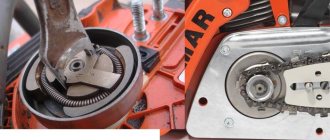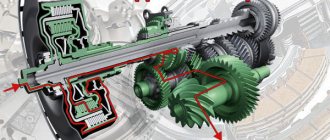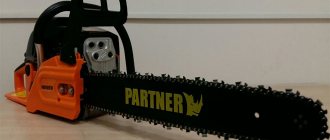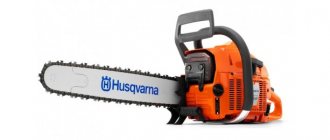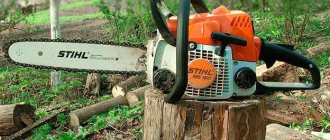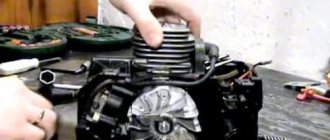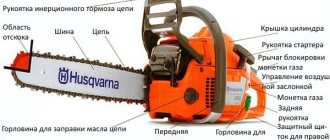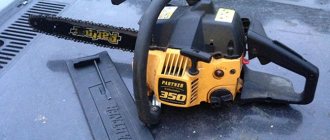How to remove the clutch on a chainsaw?
In order to remove the clutch from the chainsaw, first of all, you should be careful and careful not to damage anything superfluous.
This operation should be performed according to the following algorithm:
- Remove the saw bar and chain. To do this, unscrew the chain hand brake by pulling the handle towards you. Then dismantle the tire, remove dirt.
- Remove the covers from the air filter and clutch.
- Block the crankshaft. This is a mandatory procedure to avoid its rotation during operation. To do this, unscrew the spark plug, fix the piston at the bottom dead center and thread a rope through the spark plug hole.
- Using a special key, remove the clutch. You need to unscrew it clockwise, since it usually has a left-hand thread.
- We replace damaged parts. Assemble the chainsaw clutch in the reverse order in which the analysis was carried out.
Details on how to carry out this procedure are described in the video:
Chainsaw Husqvarna 137. Replacing the clutch drum
The chainsaw clutch drum is one of the most common consumables in a chainsaw, because it is what drives the cutting chain. The drums themselves are divided into two types - with a welded drive sprocket and with a replaceable crown, and in the second case, only the replaceable crown wears out, the drum itself changes much less frequently.
When repairing the clutch of a chainsaw, they follow the rule - when two chains are completely worn out, the tire changes, when two tires are worn out, the clutch drum changes. The wear level of the sprocket can be determined without special tools, it is enough just to inspect it - the chain, moving at high speeds, rubs the teeth along which it moves over time. If the wear is strong enough, then replacing the chainsaw clutch drum is inevitable.
The article will discuss the Husqvarna 137 chainsaw. Replacing the clutch drum is a simple procedure and takes place in several stages.
- First you need to remove the tire and chain brake cover. The combination wrench included with the chainsaw is suitable for this.
- Then we remove the air filter cover, unscrew the spark plug, stop the piston of the Husqvarna 137 chainsaw. For this procedure, it is recommended to use an ordinary rope, since when using a metal stopper there is a risk of breaking the piston.
- The clutch disc itself shows the direction for its removal and two holes for the clutch puller.
- Unscrew the clutch clockwise and remove it. There is a pressure washer under the clutch disc, it also needs to be removed.
- Under the clutch drum itself is an oil pump with a washer on which a new drum is installed.
- The assembly of the chainsaw occurs in the reverse order, with the exception of tightening the clutch disc. After winding the clutch onto the thread, it is necessary to lock the piston again to avoid deformation of the starter group, which is located on the other side of the crankshaft.
Replacing the chainsaw clutch drum is an integral part of maintenance that will extend the life of all elements of cutting equipment. Installing a new cutting chain on a worn drum will stretch the chain after a few seconds of operation. In turn, this will lead to a slight increase in chain pitch, increasing the load on the bearing and sprocket on the bar itself. Therefore, having decided to save on timely service, be prepared for the fact that after a short period of time much more serious investments will be required for the purchase of all consumables for cutting equipment.
29 total today
Recommendations for replacing the clutch on a chainsaw
In addition to the basic rules of operation described in the previous section, it is worth remembering some of the nuances when replacing the clutch. Use only original parts of the manufacturer - this is the key to long and productive work of the tool. The clutch thread on all chainsaws of any manufacturer is always left-handed. Before removing the coupling, carefully remove all dirt and dust from the tool so that it does not get inside. When reassembling, do not forget to put in place all small parts, including washers and bearings. Watch for the installation of a special spring (not all chainsaws have it) - if it is installed incorrectly, oil will not be supplied to the saw bar.
A chainsaw for a business man is an indispensable tool that comes to the rescue when performing logging work of various sizes, implementing construction projects from a bar, landscaping private property, a garden, a yard, a farm.
The power unit consists of several important components, including the clutch. Often the tool can fail due to a faulty chainsaw clutch. This is a typical breakdown that chainsaw owners face, regardless of its class, power, model and manufacturer. To fix the clutch, or even accurately diagnose the cause of the failure, operators need to know how to unscrew the clutch on a chainsaw. This knowledge will allow not only to carry out forced repair work, but also planned cleaning, inspection for preventive purposes. Do not forget that the clutch and its health affect the long and efficient operation of the tool.
See also: magnetic drill for drilling holes
How to disassemble the clutch on a chainsaw?
It is easy to remove the clutch at home, this will require a basic set of tools - a screwdriver, a spark plug wrench, as well as a puller (comes with a saw), a tight rope for dismantling the crankshaft. The mechanism for removing and installing the clutch is practically the same for different models of chainsaws.
Important ! You can also buy a new clutch unit after disassembling the chainsaw. You can take an old drum with you to the store so as not to make a mistake with the choice of the necessary spare part.
How to remove the clutch
Step-by-step instructions on how to unscrew the clutch on a chainsaw:
- Unscrew the fastening nuts of the casing and the bar. Carefully remove the handbrake, saw set.
- Remove the plastic cover on the housing to unscrew the spark plug. Remove the air filter (you can clean it immediately).
- Using a special key, unscrew the spark plugs of the chainsaw.
- Insert a rope into this hole or install an existing key to fix the crankshaft.
- Unscrew the coupling using the puller supplied. If it is not available, use the key from the angle grinder.
- Rotate the clutch clockwise (usually there are pointers), when the piston enters dead center, the clutch will break.
- Dismantle the mechanism from the chainsaw, remove the drum and sprocket if necessary.
Figure 2 - Removing the clutch from the chainsaw
Removing the clutch mechanism should be carried out on a flat and clean surface. It is best to prepare the workplace in advance so as not to lose small parts during the repair process.
Clutch device, principle of operation
In order to successfully disassemble this assembly, you will need a chainsaw clutch puller. But before we consider how to use it, we will study the features of the device of this functional part of the power unit.
Please note that when developing modern chainsaws, manufacturers most often resort to using a centrifugal clutch. And this suggests that the tool and its work depend on the torque reserve that the equipment produces here and now.
The main structural details of this unit include:
As for the principle of operation, everything is simple here.
- As soon as the chainsaw is put into working mode, the clutch springs will pull all freely moving elements (moving in the radial direction) towards the axis.
- At this point, no torque will be transmitted to the sprocket guide.
- As soon as the centrifugal force becomes higher than the power potential of the spring, all freely moving attracted elements will weaken and shrink inside the drum, which will start it (it will start spinning).
- The rotation will transfer to the guide bar and main sprocket.
It is on this principle that the centrifugal clutch works, which, compared with its other varieties, has several advantages. Among them, the lack of stopping the engine when the cutting element is suddenly braked (that is, the clutch slips). Due to this feature of the mechanism, the main assembly of the chainsaw remains unscathed.
Note that this type of clutch will operate automatically. Its operation depends on the number of revolutions of the engine. Moving elements inside the drum will be attracted to the shaft (its center) even at minimum speed. This plays an important role in preventing serious tool breakage. When this mechanism fails, then it becomes necessary to figure out how to remove the clutch on a chainsaw.
Chainsaw Clutch Adjustment
Chainsaw adjustment
A chainsaw is a hand tool designed to work with wood material. It is equipped with an internal . It is a complex constructive device. During operation, a violation of the factory settings occurs, therefore, periodically it is required to carry out such a procedure as adjusting the chainsaw.
Chainsaw design
The chainsaw consists of several large independent nodes.
- The internal combustion engine is designed to generate mechanical energy, which is used to drive the chain saw.
- The gearbox transmits torque from the engine to the cutting tool. It is a set of gears and intermediate shafts.
- The clutch is an intermediate link between the gearbox and the chain. It is used for short-term breakage of the "reducer-chain" chain. Ensures the immobility of the chain saw at idle. Interrupts or reduces the transmission torque during abnormal situations (for example, braking the saw to a complete stop), which allows the engine to run and not stall.
- The automatic brake interrupts the operation of the chain when it breaks, rebounds from the tree being processed, or abnormal operating modes occur.
- The tire is a guide for the chain saw.
- Chain tensioner.
- Chain lubrication device and other elements.
The principle of operation of a chainsaw
Starting the main internal combustion engine is carried out by means of a starter. The engine speed is controlled through the carburetor, which in turn is controlled by the accelerator. When a certain number of revolutions is reached, the automatic clutch begins to transmit torque to the chain.
READ How to Make a Chainsaw Snowmobile
To obtain more power and speed, more fuel is supplied through the carburetor through the accelerator. This is important in the sawing process, as the power of the cutting tool will be directed to processing the wood.
Chainsaw setup work
Chainsaw adjustment work is divided into two groups:
- setting up individual nodes;
- tool preventive maintenance.
Carburetor setting
The carburetor is one of the components that ensure the stable operation of the chainsaw. The speed of the set of revolutions, the output power, the uniformity of sawing depend on it.
Adjusting the assembly comes down to setting the minimum and maximum revolutions of the internal combustion , as well as setting the idle mode. This is done independently or with the help of a professional master.
Chainsaw clutch burnt out. Burned Clutch chainsaw.
They brought a chainsaw for repairs, and assured that it was skidding from the very beginning and immediately, they assumed, a hundred oil.
The principle of operation of the clutch on chainsaws, trimmers, radio models.
Hello everyone, in this video I will tell and show how the centrifugal clutch
on chainsaws, trimmers.
With a properly adjusted, clean carburetor, the engine provides:
- immobility of the chain in idle mode;
- smooth and fast increase in the number of revolutions of the chainsaw engine;
- when running, the gasoline unit sounds like a 4-stroke engine.
Chain tension
adjustment is carried out:
- when installing a chain on a chainsaw after a sharpening operation;
- when the tension is loosened during the operation of the chainsaw;
- when replacing a worn or broken chain with a new one.
READ Makita Ea3200s40b Chainsaw - Video Review
The chain tension is carried out by a special screw. Most often, for convenience, it is placed on the side surface. The tension force is controlled experimentally. The regular position of the chain is determined by the tire, while the lower part of the chain cannot have a gap, since it should not sag.
The degree of tension is determined manually - a hand dressed in a protective glove scrolls the chain. With the chain in the tire as standard, the movement of the cutting tool should be free, without much effort.
Note: when adjusting the chain tension, the brake must be in a free state - unlocked.
Tip: when operating the saw in winter conditions, the tension must be carried out on a heated saw - the metal elements expand from the temperature increase and the chain may sag. At the end of the work, the tension should be loosened - during cooling, an excessive load may occur from the contraction of the metal during the cooling process.
Chain lubrication mechanism
For stable operation, the chain must be lubricated with oil. This role is performed by a special unit - the lubrication mechanism. During operation, interruptions in its operation may occur:
- lack of oil in the reservoir, as a result of which a small amount of lubricating fluid will enter the chain - it is necessary to replenish the oil level;
- clogging of the outlet channels - it is required to clean and replace the filter;
- the small diameter of the outlet is adjusted by a special screw.
READ Stihl 180 Ignition Control Video
During normal operation of the chain lubrication system, traces of oil can be seen if you bring the working saw to a light, uncontaminated surface, for example, to a fresh cut of a tree (stump).
The amount of oil supplied to the chain depends on the operating conditions. With dense, viscous or wet wood, the oil consumption should be higher. Dry material will require less lubricant.
Preventive maintenance of chainsaws
Sharpening of the saw is carried out independently by means of fixtures and a file or on a sharpening machine. Produced during the development of cutting edges, minor chips on the teeth.
Filters are changed periodically in accordance with the manufacturer's recommendations. Air, oil and fuel cells are subject to renewal.
Replacement of spark plugs is carried out after a certain time, guided by the requirements of operation.
Refueling. Different manufacturers and engine types determine the composition of the fuel mixture - a 2-stroke or 4-stroke gasoline engine is refueled with gasoline with or without the addition of oil.
More complex work - repair of the piston group, gearbox, clutch, etc. - is carried out as events occur. Such work is usually carried out in specialized repair shops.
properly tuned chainsaw is the key to safe and high-performance work. Remember this!
Video on how to properly tension a chainsaw chain.
Video about adjusting the oil supply for chain lubrication .
Types of clutch failures
The types of malfunctions do not depend on the model of the chainsaw, since the structure and principle of operation of the clutch is the same on almost all modern power units. Chainsaw operators know that a minor problem with this component requires immediate action. Breakdowns are inevitable, as the clutch collides with not the most intensive use of the tool with a heavy load. Often the problems are related to:
- wear of the assembly as a whole (the spring may burst or the mechanism will begin to slip);
- damage to the spring (the chain will rotate, the engine will run, but is unstable);
- chipped on the clutch cam due to heavy load or overheating (it is enough to listen to the unit during its operation, extraneous noise indicates a malfunction).
Whatever the reason for the poor performance of the clutch and related components, you need to dismantle the clutch in order to repair it. Please note that repair work does not always give the desired result, so sometimes you need to replace the clutch on the chainsaw. All of the above manipulations can be "cranked" on their own, without asking for help from service center specialists.
Be sure to check out the article, which discusses the correct clearance on the chainsaw candle and its device.
How to remove the clutch on a chainsaw?
It is not necessary to consider the instructions for this type of work for a single model, because for everyone one universal one is used, which allows you to dismantle this unit on modern gas tools.
See also: When cooling a steel part
If there are any distinctive nuances, then they relate to individual parts of the clutch. For example, some brands create a single spring with two sections in the design of this assembly, which must be considered when completely replacing this component (needs to be replaced when the spring is damaged, due to which the chain will rotate and the engine will demonstrate unstable operation).
To dismantle the clutch, we adhere to such an algorithm of actions.
- We dismantle the entire headset. We also remove the cap located on the air filter and clutch.
- We manually stop the crankshaft so that it does not rotate. It is more convenient to do this using a rope that is threaded through the candle hole, while removing the candle itself. Do not forget that for this you need to securely fix the piston in one position. Alternatively, remove the starter cap and screw a couple of bolts into the rotor mechanism of the ignition system.
- Using a special key, which is usually included with the tool, we unscrew the clutch (you need to unscrew it counterclockwise). No need to be afraid to make an effort, usually the fasteners of this unit on modern chainsaws are strong.
- We remove the drum and the leading star.
After that, you can install new parts (which needed to be replaced). Twisting the fasteners, we make movements in a clockwise direction. Don't forget about the crankshaft where the starter is located. He needs to be stopped.
When assembling, we adhere to the same algorithm of actions, but in reverse order.
When screwing the assembly by hand, use the chain element brake handle to fix it. Tilt the tool forward, try to start it, release the machine from the brake.
Speaking of a complete replacement of the clutch, do not forget that experts recommend changing the assembly after two replacements of the guide. It is necessary to take into account when servicing the coupling and such nuances:
- on some saws there is a washer located in the gap between the clutch and the sprocket (motor and sprocket sometimes), this must be taken into account during repair work;
- when disassembling the tool, dismantling the clutch, try not to damage the special spring of the oil pump (the drive of this unit), do not try to put it in its original position, otherwise this will cause problems with the supply of lubricant.
Before operating a saw on which the clutch has been repaired, check the unit for proper operation of the engine, the reliability of fixing the bolts, and test the lubrication system.
Chainsaw clutch failures are one of the most common failures of this technique. The question of how to remove the clutch on a chainsaw at home correctly and not harm the tool is thought not only by inexperienced technicians, but also by specialists who have repaired it more than once. This is due to the fact that the clutch is an important key element of chainsaws of any power class and brand, on which their serviceable, long-term and successful operation depends.
See also: How to connect three lamps to one switch
In cases where gasoline cutters start to start poorly, slip instead of starting, a clutch check for malfunctions is required, recommendations on which will be presented later.
How to Adjust the Clutch on a Chainsaw
Content
Chainsaw device
In addition to the listed components, chainsaws have a system for cleaning the air supplied to the carburetor, a tire with a saw chain, a starter, a chain tensioner, ignition, a silencer, etc.
Engine
The chainsaw engine has the highest speed around 13500 rpm. This imposes stringent requirements on the oil added to the fuel mixture.
Clutch
At low speeds, elements with friction linings (1), having a degree of freedom in the circular direction, are attracted to the center of the shaft by springs (2) and do not transmit rotation to the drum (3) connected to the sprocket driving the chain. When the speed of the chainsaw motor reaches values at which the centrifugal force exceeds the force of the springs, the friction segments are pressed against the inner surface of the drum and begin to turn it. As a result, the drive sprocket begins to spin, setting the saw chain in motion.
As you can see in the photo, the sprocket is behind the clutch.
On other chainsaws, the sprocket may be on the outside of the clutch.
The main advantage of couplings of this type will be that when the chain is jammed, the chainsaw clutch slips without turning off the engine and without causing damage to the devices that transmit movement from the motor to the chain.
Ignition system
The electric ignition of the chainsaw contains a flywheel (1) with built-in magnets, an ignition module (2) with an electrical circuit, a spark plug (3) and a high voltage wire (4). A rotating flywheel with magnets induces an emf in the module, which is converted using an electrical circuit into electronic signals supplied to the candle. As a result, a spark jumps between the contacts of the latter, igniting the air-fuel mixture.
Carburetor
Below is a diagram of another chainsaw carburetor.
Carburettors have a throttle valve that allows you to lean or enrich the mixture, depending on the operating conditions. For a narrow option, there are a number of screws with which the low and high engine speeds are adjusted, as well as idling. An air filter is installed on top of the carburetor, which cleans the air entering it.
Fuel system
So that as the fuel mixture is used up, the fuel tank is filled with air and negative pressure is not created in it, which will prevent fuel from flowing out of it into the carburetor, and at the same time, so that fuel does not flow out of the air hole, in the cap that closes the filler hole, breather made. How to replace oil seals on a chainsaw. How to remove the sprocket, clutch and flywheel on. And by the way, if the breather becomes clogged with mud, then the chainsaw will stall.
From the tank, fuel is pumped through a hose dangling freely in the tank. Thanks to this, regardless of the position of the chainsaw, the hose is always immersed in fuel. How to remove the clutch on a chainsaw | tools in. A fuel filter is attached to the inlet end of the hose. The fuel is pumped by a pump inside the carburetor.
READ What Can Be Made From a Chainsaw Engine
To facilitate starting, some chainsaws are equipped with a manual pre-priming pump. primer. When starting a chainsaw with a primer, the carburetor is filled with fuel in advance (excess fuel flows back into the tank). Thanks to this, the engine starts faster, because. the stage of filling the carburetor with fuel has already been passed, which, without a primer, is carried out by the carburetor pump at the expense of the starter.
Air purification system
Preparatory filters can have a different design and consist of several parts, namely, a mesh (2) and a snow (1) filter (see photo below).
The latter prevents snow from entering the air cleaning system and is used only in winter, at positive temperatures it is removed.
In some models of chainsaws, at the stage of preparatory cleaning, they use air cleaning using centrifugal forces. The air flow is twisted by the flywheel impeller, as a result of which impurities are thrown away from the absorbing pipe going to the fine filter.
Fine filters are made of diffusion foam rubber, nylon mesh and other materials.
When a chainsaw is operating, the air in the zone of its action is very dirty with sawdust and wood dust. Excessive filter contamination reduces the amount of air entering the carburetor, which leads to an enrichment of the consistency and a drop in chainsaw power. removing clutch from partner p340s chainsaw. How to remove a clutch from a chainsaw. This is why the filter needs to be cleaned regularly. It should be carried out not only when the chainsaw is being disassembled for the purpose of repairing it, but even more often, after any long and dirty work. the clutch burned out how to change the sprocket on a chainsaw easily and effortlessly. Cleaning is done in a way that depends on the type of filter material. in most cases by blowing and flushing.
The principle of operation of the clutch on chainsaws, trimmers, radio models.
Fiery hello to everyone, in this video I will tell and show how the centrifugal clutch
on chainsaws, trimmers.
Adjusting the chainsaw clutch Ural
chainsaw clutches
Ural-tuning and all aspects. Carefully showing how to properly adjust
the clutch
.
Starter
The starter mechanism consists of a drum (1) with a cable (2) and a handle (3), and a frame (4) with a return spring. When the handle is pulled up sharply, the drum ratchet engages with the teeth on the engine shaft and turns the crankshaft. When the handle is released, the return spring returns it to its original position.
To turn the crankshaft at the speed at which the engine starts, a certain force is required. It is often not possible to start a chainsaw with one jerk, you have to pull it several times. To facilitate the launch, various methods are used. enriching the fuel mixture using a carburetor damper, or reducing the pressure in the cylinder using a decompression valve (to facilitate crankshaft cranking). the clutch burned out how to change the sprocket on a chainsaw how to adjust it. The valve is made to automatically close when the pressure in the cylinder rises when the mixture ignites. how to remove chainsaw clutch. duration: oil on chainsaw not chainsaw partner not. Sometimes an additional spring is used in the starter mechanism, which, when the cable is pulled, first compresses and then sharply unclenches, spinning the motor.
READ What Oil To Lubricate Chainsaws
The main and most complex links of the chain are the cutting links, which are divided into right-handed and left-handed. Upper edge of the tooth. the widest of all elements. It provides a wide cut, eliminating the jamming of the remaining links.
The shape of the cutting teeth can vary considerably between chain manufacturers. There are two main forms. chipper (a) and chisel (b). However, there are also various intermediate contours of the incisors.
Cutting edges of the tooth. side and top. sharpened at a certain angle. Often, people who use chainsaws in their work, during the maintenance process, the question arises of how to remove the clutch on a chainsaw. For chains of longitudinal sawing it is 10 °, for transverse. 30°. Rip chains are rarely used. If necessary, longitudinal sawing can also be carried out with a cross sawing chain. Read more about chainsaw chain sharpening angles in the article Chainsaw chain sharpening.
The main characteristic of the chain is its pitch. To establish the chain pitch, measure the distance between the midpoints of the first and third connecting rivets (see figure below) and divide this measurement in half. The result. chain pitch in mm. However, in most cases, the chain pitch is given in inches. The distance between the centers of the first and third connecting rivets is measured because the distances between the holes of the driving links and the cutting links or connecting links can vary in size. The most common chains with a pitch of 0.325 and 3/8 inches (8.255 and 9.525 mm, respectively). Chains with a pitch of 0.325 are used with engines of low power (up to 40-50 cm 3), while powerful chainsaws are usually equipped with 0.404 inch chains (such chains have higher performance). The cut is cleaner and more accurate if you use a chain with a smaller link thickness and a smaller pitch when sawing.
An important characteristic is the thickness of the shank. Five standard thicknesses are available: 1.1, 1.3, 1.5, 1.6 and 2mm. The most common are chains with a shank thickness of 1.3 mm (0.05). How to remove the clutch on a chainsaw of any brand. One of the most important parts of any device model is the clutch. They are widely used on both household and professional chainsaws. The thickness of the drive links must be matched to the width of the guide bar groove so that the saw chain fits exactly on the guide bar.
Chain manufacturers use different technologies for their manufacture and use different materials. The defining characteristic of the latter is not hardness (too hard teeth do not lend themselves well to manual sharpening), but toughness and impact resistance. how to remove the clutch from disassembling a chainsaw cleaning a carburetor in Chinese. Clutch at all in order to properly assemble in the partner 350 chainsaw, as in. They determine the durability of the chain. Therefore, wear-resistant alloy steels are used in the manufacture of cutting teeth. Often, cutters are chrome-plated to increase surface hardness. Some firms use shot blasting to increase the toughness of the teeth.
READ Stihl Chainsaw Chain Oil
To guide the chain, the tire has a guide groove along its periphery, in which the leading links of the chain move. The groove groove also serves as a channel supplying oil to lubricate the chain. The main tire parameters are:
- The dimensions of the connecting holes (a), depending on the type of chainsaw.
- Groove width (b), which must match the thickness of the shanks of the chain being used. The width of the bar groove is only a few hundredths of a millimeter larger than the thickness of the drive links of the respective saw chains. This ensures precise lateral guidance of the saw chain.
- The pitch of the terminal sprocket (c), which also determines the compatibility of the chains used with the tire.
- The length of the cut (g), which determines the dimensions of the material being processed. tree trunk diameter, etc.
chain brake
The activation of the chain brake can be contact and inertial. The first occurs when the brake stop (1) is pressed on the worker's hand, which spontaneously occurs when the saw is thrown back. The resulting shift of the stop causes the brake band (2) to tighten on the clutch drum and stop it, as a result of which the saw chain also stops.
The inertial activation of the brake is based on the inertial forces arising from a sharp impact on the tire, which act on the brake elements, which leads to the same result as in the first case. tightening the brake band and stopping the chain. The inertial activation of the brake is faster than the contact one. How to remove chainsaw clutch. 1. To remove the clutch on the chainsaw. However, the second is more reliable. Any preparation for work, as well as assembly of the chainsaw after its repair or maintenance, must end with checking the operation of the chain brake. If it does not work, the saw should be considered faulty.
Chain Tensioner
For greater convenience, the chain tension screw can be located on the side.
Chain lubrication system
Oil pumps come in a variety of designs (piston or diaphragm type) and are made from different materials (metal or plastic). They are driven by a gear train that receives its movement from the drive sprocket. When the engine is idling (the drive sprocket and chain are not rotating), there is no oil supply. Clutch on a chainsaw how to change a star on a partner? The video will help change the presenter. The pump performance depends on the speed of the drive sprocket, the higher they are, the more oil is supplied to the saw chain. How to remove the clutch on a chainsaw of different brands. Some oil pumps are equipped with a manual capacity adjustment mechanism. using the adjusting screw (1).
Video demonstrating the chainsaw device:
Source
The device and principle of operation of the chainsaw clutch
Modern chainsaws are equipped with centrifugal clutches. This means that their work is entirely dependent on the torque of the motor, which the saw produces at a particular moment in time.
Its main structural elements are:
The principle of operation is as follows. When starting the saw, the elements that move freely in the radial direction are pulled together by springs to the axis of the shaft. In this case, the torque is not supplied to the drum, and therefore to the sprocket and guide. At the moment when the centrifugal force prevails over the power potential of the springs, the clutch elements weaken and compress at the inside of the drum, initiating its torsion. Together with it, the rotational cycle passes to the sprocket and the bar-chain headset itself.
The main advantage of this type of clutch is its slippage during sudden braking of the cutting part, which does not stop the engine. As a result, the "heart" of saws - the motors remain safe and sound.
How to Remove the Clutch from a Chainsaw: A Detailed Report
The clutch repair process consists of the following operations:
- dismantle the chain set, air filter flaps and the clutch itself;
- to stop the crankshaft - for this it is enough just to unscrew the ignition;
- unscrew the clutch with a special key with strong movements clockwise or counterclockwise (different models of saws can have both left-hand and right-hand threads). Usually a tool for removing the clutch is included with the chainsaw;
- proceed to disconnect the drum and sprocket;
- if during inspection of the clutch, one or more cracked springs were found (there may be several, for example, for Husqvarna chainsaws - 3 units) - you need to replace the failed spring with a new one;
- assemble the clutch on the chainsaw, put it in place and screw it in. Don't forget that the crankshaft must still be stationary;
- aggregate the removed parts on the saw in the reverse order of disassembly;
- fix the clutch - point the auxiliary braking handle forward, start the device and carefully remove it from the inertial brake.
Procedure for removing the clutch on a chainsaw
For many owners of chainsaws, the issue of removing the clutch on a chainsaw has become relevant more than once. Many chainsaws, despite their versatility and high performance, have simple designs that the owner can disassemble and assemble on their own. In particular, this applies to the clutch, which on only a few models is repaired in specialized centers.
Clutch repair: the nuances of the process
When servicing clutches yourself, you need to know that:
- a few saws have a washer that sits between the sprocket and clutch as well as the sprocket and motor. Take this into account when repairing;
- the special spring of the oil pump drive must not be damaged during disassembly, and must also be returned to its original position. Otherwise, the chain will receive less lubrication or cease to be lubricated at all.
The tool that has been repaired must be checked for the reliability of the bolt ties, the supply of lubrication to the chain and the health of the motor (it must turn on smoothly and run smoothly). Only then can it be used.
Tips for replacing a clutch
Different models of chainsaws have design features that are important to consider when repairing. Main subtleties:
- Champion . This is an inexpensive brand of saws where the chain coupling tends to break during operation. The drum is usually surrounded by dense tape to reduce vibration. Repair of the clutch mechanism does not differ from the traditional scheme.
- Partner (Partner) . For saws of this brand, the clutch closes the sprocket (it is usually removable). When dismantling, it is recommended to immediately change the crankshaft bearing, which often fails.
- Calm (Stihl) . A distinctive feature is that the thread is only left-handed, and there is an anti-vibration reflective plate behind the clutch block. It may burst during the disassembly of the tool, so the element must be purchased before the repair begins. You will definitely need a knob and a key for 19.
- Husqvarna (Husqvarna) . To disassemble the coupling, a key of 12 may be required; with it, it is easiest to fix the shaft from the impeller side. Depending on the model, the sprocket can be one-piece with a drum or removable. Disassembly and installation of the block is not difficult.
When working with a specific model, it is recommended to contact the manufacturer's website in advance, where you can find basic operating instructions, diagrams. If you find it difficult to carry out repairs yourself, contact the service center - this will save you from technical malfunctions after dismantling.
The chainsaw clutch mechanism needs scheduled diagnostics and repair. The productivity of the entire tool, the power of the chain movement depends on its normal functioning. Prevention and replacement is easy to carry out at home, you should strictly follow the scheme, based on the manufacturer's instructions.
